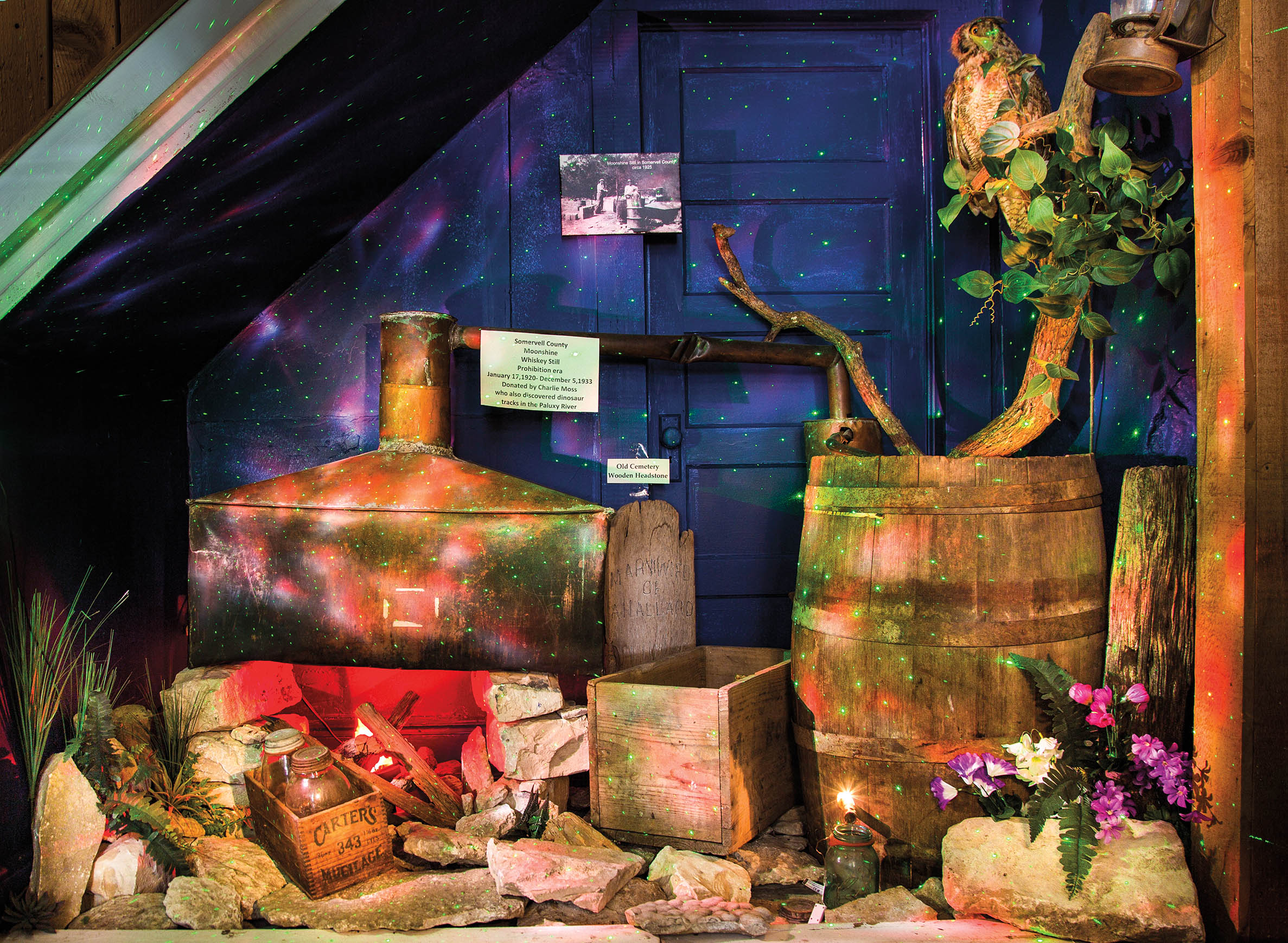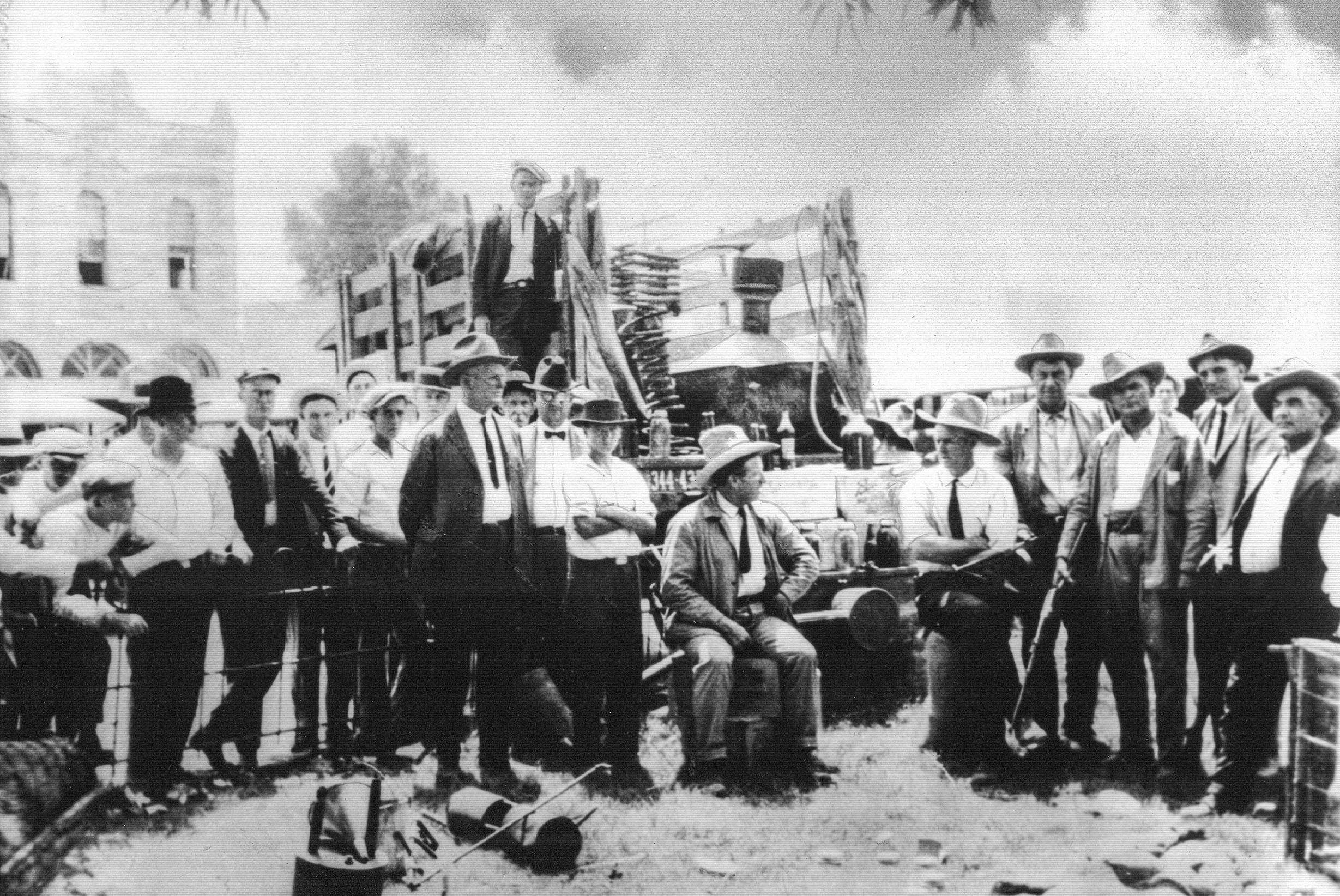
Red flames flicker under a century-old still at the Somervell County Historical Society Museum in Glen Rose. Though the cookfire is a wood-and-paper replica and the vintage copper tank hasn’t been used to make liquor for at least 60 years, the exhibit recalls the Prohibition era, when outlaw distilleries bubbled with moon-shine among Glen Rose’s cedar breaks and limestone creeks.
The still belonged to the late Charlie Moss, a moonshiner who donated his old equipment to the museum in 1965. Charlie grew up farming maize, corn, oats, and hay. When the federal government enacted Prohibition in 1919, 25-year-old Charlie was one of many farmers who seized on continued demand for alcohol by making whiskey.
“Everybody thinks making whiskey was a glorious job, but it was hard work,” says Charlie’s son, James Moss. “They always cooked at night.”
James, now 75, recalls his father working under cover of darkness and hauling heavy bags of sugar and fruit jars into the woods. Charlie would cover his tracks by fashioning a rectangle made of mesh wire and attaching burlap to it, similar to snowshoes. He aged the spirit in white oak barrels, but he didn’t drink his product—he’d only take a sip to test the taste.
“People used to tell me, ‘Your daddy made the best whiskey,’” James says.
Farmers have been making their own whiskey for centuries, handing down recipes through the generations. The craft took on a different significance in 1919, when Congress passed the 18th Amendment to outlaw the manufacture, sale, and transportation of alcohol—but not its consumption. Bootleg whiskey soared in popularity, acquiring the nickname “moonshine” because distillers worked at night to avoid the law.
The hills around Glen Rose proved to be a convenient place to conceal homemade stills for making hooch. The streams feeding the Paluxy River and Squaw Creek supplied fresh water, while local merchants sold the key components of sugar, grain, and fruit jars. Moonshiners made the product, brokers sold it for the highest dollar, and money flowed back into the local economy.
The national temperance movement, which blamed societal ills like unemployment and crime on booze, began long before Prohibition. Preachers condemned alcohol from their pulpits, and organizations such as the Anti-Saloon League sprang up around the country, including in Dallas in 1907. Texas Prohibitionists argued saloons were the “enemy of civilization, home, life, and property.”
Known as “drys,” temperance reformers pushed for local-option laws that gave towns and counties the authority to outlaw alcohol. The Texas Legislature added these laws to the state constitution in 1876. By 1908, only 25 counties in Texas remained completely wet, although an attempt to enact a statewide alcohol ban failed in 1911.
In her 2016 book, The War on Alcohol: Prohibition and the Rise of the American State, Harvard University history professor Lisa McGirr chronicles the role of Morris Sheppard, a U.S. senator from Texas who sponsored what became the 18th Amendment. Sheppard drew a distinction between personal consumption of alcohol and the profiteering of saloons and manufacturers. “I am fighting the liquor traffic,” he said. “I am against the saloon. I am not in any sense aiming to prevent the personal use of drink.”

In addition to homegrown hooch, Texas also kept “semi-open doors” for outside booze to enter from the Gulf of Mexico and the southern border with Mexico, where alcohol remained legal. Large quantities crossed the border in the 1920s and early ’30s.
Galveston’s nightclubs and underground casinos also flouted Prohibition, buying alcohol from Caribbean vessels. When authorities cracked down on the offshore liquor trade, moonshining surged on the island, Baker says.
“We not only had an international boundary over which illicit alcohol could be brought, but we had the Gulf of Mexico for rum runners in speedboats,” he says.“These were great big speedboats full of booze they could bring to isolated little places because they were shallow draft and could go right up to a beach in the middle of nowhere and unload.”
Though later celebrated in films and TV shows about mobsters like Al Capone, the era was dangerous for both lawmen and criminals. In San Antonio, Charlie Stevens was the federal liquor agent tasked with enforcing Prohibition. His nemesis was the gangster Lynn Stephens, who was known as the “rum king” and headed the city’s largest bootlegging ring. In his book, Baker recounts the tale of Stevens and Stephens, complete with stills hidden in the South Texas brush, raids, ambushes, and murder. Stevens was killed in a 1929 shootout in Bexar County with Stephens’ gang, eventually leading to a murder conviction for Stephens.
The Moonshine Spirit
Though Prohibition is long gone, it’s illegal in Texas to operate a still without a commercial distilling license. Legal distilling has found passionate followers around the state with distilleries purveying high-proof, moonshine-style whiskey.
Moonshine Ridge, Johnson City
Two brothers from Kentucky, Tom and Jason Hicks, continue a family tradition that began in the Bluegrass Hills, using their grandfather’s corn mash recipe. Their moonshine-style liquor ranges from clear and unflavored to infused with cinnamon or aged with burnt whiskey barrel chips.
moonshineridgeinc.com
Rio Grande Distillery, Port Isabel
Raised in the backwoods of the Ozark Mountains, Jerrod Leon Henry opened the Rio Grande Valley’s first distillery in 2020. He puts a Mexican spin on moonshine with flavors like horchata, cantaloupe, watermelon, and mango to make aguas frescas moonshine.
riograndedistillery.net
Sledge Distillery, Tolar
Located north of Glen Rose and west of Granbury, this distillery on a working ranch uses a more than 80-year-old family recipe to make moonshine and other spirits. Its specialty moonshine, Brimstone, is infused with Hatch green chiles.
sledgedistillery.com
In Glen Rose, moonshining was so prevalent the town became known as the “Moonshine Capital of Texas.” Cotton farming had depleted the soil, so moon-shining offered a way for rural people to support their families. “It was the only way you could make money back then,” James Moss says. His father even constructed stills for customers.
Law enforcement generally looked the other way in Glen Rose, given the economic reality of the times, according to historian Martin Brown, author of the 2017 book The Glen Rose Moonshine Raid. The Sycamore Grove Filling Stationeast of town, now a ruin of petrified wood walls, offered gas and alcohol. The White Rock roadhouse next door, now torn down, was known as a speakeasy.
“Everybody was making money,” James says. “They would know where a boot-legger was and keep their mouths shut. If somebody came in and asked where Charlie Moss lived, they wouldn’t have gotten an answer.”
Glen Rose bootlegging became so prolific it attracted the attention of Gov.Pat Neff, who sent in the Texas Rangers. In August 1923, the Rangers fanned out into the hills, confiscating stills and moonshine, and making arrests—though Charlie was not among those arrested.
According to Brown’s book, the men arrested were marched into the courthouse. “By the early afternoon, the courthouse lawn was stacked with seven whiskey stills, 66 gallons of corn liquor, eight gallons of wine and 800 pounds of sugar,” Brown wrote. That turned out to be only a “small portion” of what the Rangers found in the hills.
Prohibition also took a heavy toll on Texas breweries, many of which had been founded by German immigrants. In San Antonio, Emma Koehler guided Pearl Brewing Co. through the period by producing soft drinks, food products, and ice. In Shiner, Spoetzl Brewery kept its doors open by making “near beer” and selling ice.
Winemaking was a niche industry in Texas in the early 20th century, and by the end of Prohibition, Val Verde Winery in Del Rio was the only surviving winery in the state. It stayed alive by growing table grapes and securing a permit to make wine for sacramental purposes.
Celebrations broke out across the country when Prohibition was repealed in 1933. But Texans would have to wait for a legal drink. Washington, D.C., delegated the regulation of alcohol to the states, and Texas didn’t lift its booze ban until 1935. Local-option laws remain a tool for coun-ties to this day, however, and five Texas counties are completely dry while doz-ens are partly dry, according to the Texas Alcoholic Beverage Commission.
After Prohibition ended, Charlie continued making moonshine, James says, but when demand sagged, he pivoted pecans. It was near the end of Prohibition in Texas when Charlie played a part in another influential chapter of Glen Rose history. He and his brother were roaming the shallow Paluxy River in 1934 when they found fossilized tracks in the limestone riverbed. Paleontologists later confirmed the sauropod tracks—along with previously discovered theropod tracks—to be among the world’s best-preserved dinosaur footprints.
These days, Dinosaur Valley State Park occupies rugged terrain that once concealed illegal whiskey stills, and Glen Rose has shed its moonshine reputation for a different nickname: “Dinosaur Capital of Texas.”








